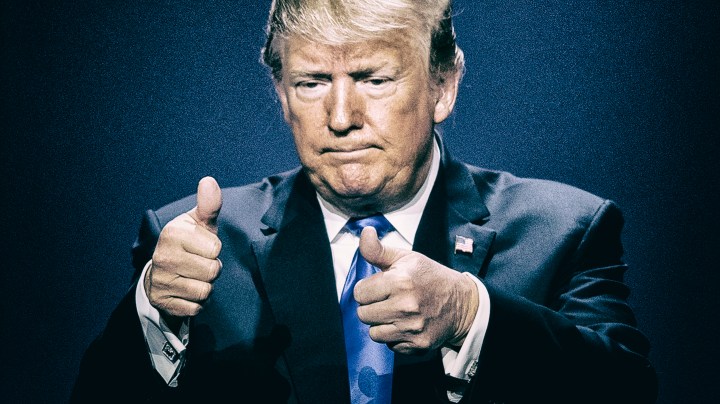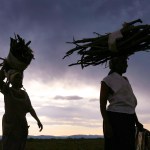US 2020
The Marathon Race for the White House – a handy guide

Over the next month or so, there are some internationally important elections to be held in Israel, Indonesia and India, and, oh yes, one right here in South Africa. Meanwhile, the long, extended American electoral process for their 2020 general election is already coming into focus, even if it is still more than a year before it reaches its conclusion. Here’s a handy guide to the American process for readers to keep.
We are already knee-deep into the next American presidential race. This is the case even though the actual election is not until 3 November 2020 and the actual inauguration of the next president (or the second term of Donald Trump) will not happen until 20 January 2021. The process, persons and complexities of the American electoral process can make it hard for non-Americans (and a whole host of Americans as well) to keep track of all the parts. So, as a public service, Daily Maverick offers readers a handy guide to the major events that have already taken place in this race, as well as those coming up that will finally lead to the conclusion of this seemingly chaotic process.
In fact, there have already been some important events in this electoral cycle. Back on 17 February 2017, incumbent President Donald Trump formally announced his candidacy for a second term. Then, five months later, a real long shot candidate (a least so far), Democratic Congressman John Delaney of Maryland, announced his candidacy for his party’s nomination.
In 2018, the Republicans selected Charlotte, North Carolina as the site for their 2020 nominating convention – partially in recognition of North Carolina’s status as a purple state which is no longer a lock in the Republican column for presidential elections (after 100 years as part of the Solid South of segregationist Democratic voters).
Later in 2018, Democratic Party officials and representatives from various television networks began discussions about the format and scheduling of the party’s candidate debates. The party also made changes in the role of super-delegates (a group of delegates comprised of already elected officials, and whose votes were the subject of some controversy in the 2018 electoral cycle). The new, agreed-upon role for super-delegates is now to be limited to voting in the first ballot, if the nomination is uncontested.
By November 2018, Donald Trump confirmed that his current vice president would remain his vice presidential running mate. Also in November, West Virginia State Senator Richard Ojeda announced candidacy for the nomination of the Democratic Party but he eventually withdrew from the race, a full year before the Iowa caucus vote in 2020.
Then, on 12 December, Former Secretary of Housing and Urban Development Julian Castro established a presidential exploratory committee for a possible run for the nomination of the Democratic Party. Such a committee is the usual first step in a formal announcement. Then, on 31 December, Massachusetts Senator Elizabeth Warren also set up her exploratory committee, before making that formal announcement on 9 February 2019.
2019
Now into 2019, so far, the following things have already taken place, or are now scheduled to happen.
On 11 January, Congresswoman from Hawaii Tulsi Gabbard made her formal announcement and, the following day, former Secretary of Housing and Urban Development Julian Castro formally announced his candidacy for the Democratic nomination. Three days later, on 15 January, New York Senator Kirsten Gillibrand announced the formation of her exploratory committee, and then her formal announcement came on 17 March.
The first quarter fundraising quarter began on 1 January, triggering some bodacious reporting requirements and much effort to generate even more money for the candidates’ campaigns. Many presidential candidates have tried to schedule their formal announcements fairly close to this date, as they cannot begin fundraising for a presidential run until they announce their candidacy formally. As a result, candidates are eager to prove their mettle with a strong fundraising haul in the first quarter.
On 21 January, California Senator Kamala Harris officially announced her candidacy for the nomination, and, two days later on 23 January, the mayor of South Bend, Indiana, Pete Buttigieg, announced the formation of his exploratory committee.
On 25 January, the Republican National Committee officially endorsed the candidacy of Donald Trump (rendering redundant the actual nominating convention, but, what the heck, it’s an excuse for a big party and some serious schmoozing with potential donors and supporters).
Meanwhile, on 27 January, Starbucks founder Howard Schultz made public his interest in an independent presidential bid, although his tease of an announcement was almost immediately the subject of some serious blowback from many Democrats – with their seeing such a candidacy as likely to put Donald Trump in the Oval Office for four more years by attracting otherwise Democratic voters.
On 1 February, making use of a Twitter account, New Jersey Senator Cory Booker announced his candidacy, and then, eight days later on 9 February, Massachusetts Senator Elizabeth Warren made her own formal announcement of her candidacy. A day later on 10 February, Minnesota Senator Amy Klobuchar made her formal announcement as well.
On 12 February, the president and former Congressman Beto O’Rourke had duelling rallies in El Paso, Texas. (O’Rourke’s rally was clearly held to set up his formal announcement for the nomination that came a month later, on 14 March.)
Meanwhile, on 15 February, former Massachusetts Governor Bill Weld announced his own formation of a thoroughly quixotic exploratory committee, thereby becoming Trump’s first official challenger in the Republican primaries. Four days later on 19 February, in an entirely unsurprising move, independent Vermont Senator Bernie Sanders announced his candidacy yet again for the Democratic presidential nomination.
By 1 March, Washington State Democratic Governor Jay Inslee had announced his candidacy and then, three days later on 4 March, Colorado’s former governor, John Hickenlooper, did likewise. On 5 March, former Mayor Michael Bloomberg of New York City announced that, after thoroughly exploring the possibility of running, he did not intend to vie for the Democratic nomination for president in 2020, and Hillary Clinton similarly announced that she too would not run for president in 2020.
On 10 March, at the Presidential Forum at “South by Southwest”, the Democrats had their first so-called “cattle call” event of this presidential cycle, where Pete Buttigieg came on very strong. On 13 March, Wayne Messam, the Democratic mayor of Miramar, Florida, announced the formation of an exploratory committee. And on 17 March, New York Senator Kirsten Gillibrand made her formal announcement that she, too, was a candidate.
In April, on the third through the fifth, numerous Democratic candidates showed up for a second “cattle call”, this time held by the National Action Network.
And on 4 April, Congressman Tim Ryan of Ohio added his name to the growing roster of announced Democratic Party candidates. And all of this, so far, has come nearly a year before the first caucuses and primaries even begin.
Now, looking forward, on 26-7 June 2019, the real Democratic candidates’ debate series, complete with television broadcasts, begins with a two-night affair in Miami, Florida, hosted by the NBC television network and to be broadcast via its various channels. On 30-31 July, the second Democratic debate is scheduled to air on CNN. August, September, October, and November will then see the third through sixth televised debates, with the final dates for those four debates not yet to be confirmed.
By the time those subsequent debates occur, various would-be candidates would likely drop out by virtue of lack of funding, or simply a realisation that they are not going to be successful, thereby making the formats a little less complex to manage by the producers and party officials.
Then there are a series of Iowa events, important because of that state’s place as the first on the schedule for a caucus or primary election. The Iowa Democratic Party Hall of Fame Dinner is scheduled to come in June or early July 2019. Traditionally, it has been one of the first big marquee Iowa events of the year that has rewarded the state’s most active Democrats for their involvement. It will be important to see how big the event space is this year – given that 2015’s dinner drew five presidential hopefuls. Then, in August 2019, there is the Dickinson County Summer Sizzler that attracts Democratic candidates to northern Iowa for local, state and national offices.
One of the really big deals for Iowa is the Iowa State Fair, running from 8-18 August. With more than 1 million attendees coming every year – and with the impossible-to-miss Des Moines Register’s Political Soapbox, this Iowa mainstay becomes a must-visit stop on the trail for candidates of all political stripes.
Also, on 9 August there is the Iowa Democratic Wing Ding Dinner. Really. This Democratic grassroots fundraising confab is 15 years old and raises funds for county democratic committees. Previous attendees have included candidates in prior elections such as Barack Obama, Hillary Clinton, Bernie Sanders, and Martin O’Malley (the former governor of Maryland).
Then on 14 to 19 August in New Hampshire there is the Londonderry Old Home Days. New Hampshire is the site of the first primary, so campaigning takes place here too. The quintessentially New Hampshire tradition of “Old Home Days” is an annual midsummer event that draws people back to their home towns for parties and a parade. It is a crucial stop for candidates of both parties. Reliably red Londonderry’s event – and parade – is an absolute must-hit for Republicans.
Then, back in Iowa, there is the Progress Iowa Corn Feed in early September. This is yet another speaking event that draws Democratic activists and candidates – plus chances to sample Iowa’s famous sweetcorn!
New Hampshire Seacoast Republican Women’s Chilli Fest is scheduled for mid-September. Historically, it has been hosted at the home of former New Hampshire speaker of the state assembly Doug Scamman and his wife Stella. This has become a fixture for campaigning over the past two decades.
Now back in Iowa again, on 21 September, there is the Polk County Democrats’ Steak Fry. This is one of the most iconic stops on the Iowa campaign trail and is yet another chance to stoke up on the local carb and cholesterol-heavy local foods. For politics addicts, this event has it all. There are chances for photo opportunities of candidates flipping giant steaks on the grill (braai), hordes of noisy campaign supporters – and, crucially, a veritable crush of national press coverage, eager to sniff out a scoop or two.
Then there is the Iowa Democratic Party Fall Gala that comes along in late October or early November. Previously known as the Jefferson-Jackson Dinner (after two early 19th century Democratic presidents), this more formal event becomes one of the Iowa Democratic Party’s biggest fundraisers of the year.
The Union Leader (of Manchester, New Hampshire) endorsement comes along in late November. There is an argument that editorials and endorsements ultimately make very little electoral difference, but, regardless, political insiders still prize an endorsement from the largest newspaper in New Hampshire. Iowa’s Des Moines Register usually does not issue primary endorsements until January of the actual election year.
Still in Iowa, there is the Progress Iowa Holiday Party, coming in mid-December. This becomes a key holiday-season draw for Democrats, both local and national alike, coming as it does just a couple of months before the state’s caucus.
2020
In 2020 we now, finally, get to the real meat and potatoes of the nomination process. This is the events list, as far as is known at this point, although several states have yet to make their final determination of their respective primaries. Therefore, here is the schedule for caucuses, primaries, nominating conventions and other key dates as currently announced:
3 February: Iowa caucus. This is the first real test of candidate strength and, along with the New Hampshire primary, can give a real boost to a winning candidate, as well as whoever comes in second, especially if the latter was expected to fade far to the back of the crowd.
11 February: New Hampshire primary
22 February: Nevada Democratic caucus
29 February: South Carolina Democratic primary
Date not yet confirmed: Colorado caucus (3, 10, or 17 March)
3 March: Super Tuesday (Alabama, Arkansas, California, Massachusetts, Minnesota, North Carolina, Oklahoma, Tennessee, Texas, Utah, Vermont, and Virginia primaries; North Dakota Democratic firehouse caucus/primary; Democrats Abroad preference vote through March 10). This primary day could effectively make the rest of the primaries largely irrelevant, given the broad roster of states and the presence of California in this list – that is, if one candidate captures many of the delegates up for grabs.
7 March: Louisiana primary
8 March: Maine caucus
10 March: Hawaii Republican caucus; Idaho Republican primary; Michigan, Mississippi, Missouri, and Ohio primaries
17 March: Arizona, Florida, and Illinois primaries
4 April: Alaska and Hawaii Democratic firehouse caucuses/primaries
7 April: Wisconsin primary
28 April: Connecticut, Delaware, Maryland, Pennsylvania, and Rhode Island primaries
5 May: Indiana primary
12 May: Nebraska Republican primary; West Virginia primary
19 May: Kentucky and Oregon primaries
22-25 May: 2020 Libertarian National Convention will be held in Austin, Texas
2 June: Montana, New Jersey, New Mexico, and South Dakota primaries
7 June: Puerto Rico Democratic primary. While Puerto Rico does not vote in the general election, it does have delegates selected for the Democratic nominating convention.
16 June: Washington, DC Democratic primary. The capital also sends delegates to the national convention and it has three of the 538 electoral votes in the general election.
13-16 July: The 2020 Democratic National Convention, at the Fiserv Forum in Milwaukee, Wisconsin. The party out of power traditionally goes first with its national convention. In this convention, the Democrats hope to use this convention to build a little momentum for their candidate’s ability to capture support from the northern Midwest states, states traditionally Democratic but, in the last election, largely falling to the Republican candidate.
24-27 August: The 2020 Republican National Convention, at the Spectrum Center in Charlotte, North Carolina
Date not yet confirmed: Presidential debates
Date not yet confirmed: Presidential debates
3 November: Election Day
Mid-December: The Electors (i.e. members) of the Electoral College meet in their respective state capitals (electors for the District of Columbia meet within the district) to vote formally for the President and Vice President. When we get that far along, we will explain the intricacies of the Electoral College in more detail. In the meantime, consider it as 51 separate elections that each give their entire population’s weight to the candidate who wins that state’s vote, regardless of the margin of victory. (A state’s electoral weight is the sum of their representatives and senators, therefore roughly equivalent to their population.)
2021
5 January 2021: Electoral votes are formally counted before a joint session of Congress; whereupon the President of the Senate formally announces the electoral result.
20 January: Inauguration Day. Finally! DM



















 Become an Insider
Become an Insider